Scoutmaster Musings
Archives:
2023 2022 2021 2020 2019 2018 2017 2016 2015 2014 2013 2012 2011 2010 2009 2008 2007 2006 2005
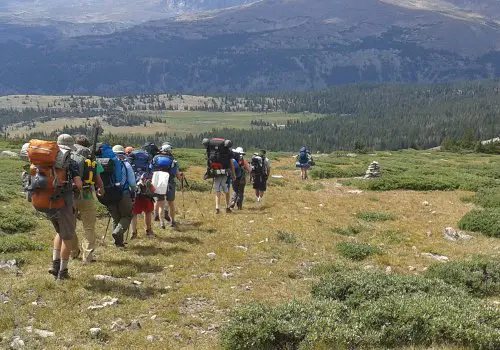

Here are 10 simple, safe, comfortable ways to cut 15 pounds or more from what you take on your next backpacking trip:
- Lose Nalgenes - (save 1lb) The Nalgene bottle is ubiquitous to backpacking and Scouting. There are at least 5 different styles available in my local Scout Shop. Each of them weigh at least 7 ounces so a scout carrying 2 has almost a pound of plastic. A 1-liter Platypus water bag weighs 0.9 ounces and costs about 75% of a Nalgene. But, a disposable soda or water bottle weighs about the same and costs <$1. The argument for Nalgene is "indestructibility" - I challenge you to break a disposable soda bottle. It's hard work! And, I did have a scout say to me, "See, it won't break" as he threw his Nalgene at a pile of rocks and then watched it shatter.
- Make Quilts - (save 2lb) Sleeping systems rely on loft for warmth. The part of a sleeping bag underneath you is compressed and has lost its loft, resulting in very little insulation. Your quilt or bedspread at home just lays on top of you, so use the same idea outdoors and cut out that compressed weight. It is a very easy sewing project to make a quilt from two layers of nylon and a layer or two of polyester insulating filler, for about $80 or $90. I've made two, one 2lb. and one 2.5lb - the difference is 1 or 2 layers of insulation. The 2.5lb quilt keeps me warm below freezing. A $25 sleeping bag can work down to that temp, but will weigh more like 4 or 5 lbs. A down quilt will weigh less, but cost a lot more.
- Make Backpacks - (save 4lb) Once you've cut the weight of what you're carrying from 50+lb down to <30lb, you can cut out the weight of your framed pack. My JanSport pack weighs 5lb and can carry an elephant, but I made my own 1lb pack for $40 and it can carry about 35lb. But, with my lighter packing, I never need more than 30lb, unless it's winter. Quest Outfitters have some very inexpensive plans and material kits so you can make packs for a group inexpensively.
- Carry Less Water - (save 3lb) I can't count the times I heard "Better fill up. We don't know when the next water stop will be." Water is the heaviest, and most important, item you will ever carry. Every liter you carry from one water source to another without drinking is 2.2lb of weight you didn't need. By using maps maps to plan water stops, you can carry just what is needed. The fear of running out of water is valid in arid areas, but the vast majority of places you'll hike will have plentiful water often. Drinking your fill at the water source, and then carrying 2 liters instead of 4 liters saves 4.5lb of excess weight.
- Water Filters - (save 1lb) Pump-action water filters, such as Katadyne and MSR, are obsolete. Sawyer Squeeze filters are light, fast, and they don't break. If every pair of scouts had one of these 3-ounce filters, you would have fast filtering, redundancy, and simplicity for a lower price. You fill a dirty water bag, screw on the filter, and squeeze, or hang and let gravity do the work. On the trail, you can just fill the bag at the source and then do the filtering whenever you want.
- Tarps & Nets - (save 4lb) Self-standing tents are easy and great for scouts. A silnylon tarp with a bug net hung underneath provides the same protection, better ventilation, and more flexibility at a greatly reduced weight. These lightweight shelters tend to cost more than tents, but DIY plans and materials are available. Quest Outfitters have a Bilgy Tarp Tent kit that is reasonable.
- That Darned Pocketknife - (save 4oz) I take a tiny 0.5oz folding knife with a very sharp blade on my long hikes. It has done everything I've needed. The everything but the kitchen sink pocketknife or multi-tool weighs a lot and is seldom used. If you really need that awl or saw, take it, but I've never needed them.
- Boots vs Shoes - (save 2lb) The discussion about wearing boots or shoes is usually very short. It's either "wear boots" or "wear shoes" with very little listening or changing of opinions. I used to wear boots, but have not since 2011. The most common reasons for wearing hiking boots that I've heard are "ankle support", "waterproof", and "durability". I invite you to search the 'net for more info, but I've worn light shoes with much more comfort, safety, and flexibility since changing my view on the topic.
- Food - (save 2lb) Most people take waaaaay too much food, and they take inefficient food. On a 3-day trek, taking 6 days of food just in case is very heavy. You already have 3 days of food just in case, so take just 1 extray day of food if you're really concerned with emergency needs. The types of food you choose also make you carry more weight for an equivalent amount of calories - ritz-style crackers have twice the calories as tortillas; olive oil is the most calorie-dense item you can carry and a few ounces of it in that dehydrated meal tastes good; nutella and peanut butter feel heavy but they have more calories by weight than many other foods. I've discovered that Aldi stores are good places to find high-calorie, low-cost backpacking foods.
- Take a Phone - (save 8oz) Cellphones are not just for phone calls, and you already know that. That 4oz pocket-sized electronic device is a camera, map, clock, alarm, info resource (first aid, skills, plants, ...), compass, gps, and much more - all while it is in airplane mode with no network connection. So, even in the backcountry, a handheld device is very useful and can save weight by leaving redundant items at home. Educating your group about how the devices should be used weighs nothing and takes only a little time.
With a little effort and $, you can cut that weight from ~50 pounds to ~30 pounds and still be comfortable, safe, and well-fed, but it's up to you.
| Leave Comment |
 A short, brisk hike down the mountain and we were back in civilization, taking showers in Buffalo, WY. We had the afternoon to explore the small town that just happened to be holding its "Crazy Days" event - basically a sidewalk saddle. My highlight was meeting this real, live, Wyoming cowboy selling lemonade with his little brother!
It was a super week with great weather having storms only at night, fun people, plenty of wildlife, and majestic views.
A short, brisk hike down the mountain and we were back in civilization, taking showers in Buffalo, WY. We had the afternoon to explore the small town that just happened to be holding its "Crazy Days" event - basically a sidewalk saddle. My highlight was meeting this real, live, Wyoming cowboy selling lemonade with his little brother!
It was a super week with great weather having storms only at night, fun people, plenty of wildlife, and majestic views. | Leave Comment |
 We spent the morning fishing after another night of intense lightning and rain. The fish were off and we caught very few but the scenery was terrific.
We packed up in the afternoon and hiked out to Soldier Park for our last night in the wild. It was a nice hike since it was almost all downhill.
We left the official wilderness after our water crossing and then camped at a very overused spot. It was a strong contrast with the more beautiful wilderness settings.
We spent the morning fishing after another night of intense lightning and rain. The fish were off and we caught very few but the scenery was terrific.
We packed up in the afternoon and hiked out to Soldier Park for our last night in the wild. It was a nice hike since it was almost all downhill.
We left the official wilderness after our water crossing and then camped at a very overused spot. It was a strong contrast with the more beautiful wilderness settings.
| Leave Comment |
 Our intrepid crew hiked from Elk Lake over a 10600 foot saddle behind Ant Hill then across a creek and up a hillside to the Seven Brothers area. This was our longest hiking day with the most elevation.
On the trail, we passed both of our other groups going the other direction.
Our new home is a VERY impacted site since this area gets heavy use.
We had horrendous lightning last night.
Our intrepid crew hiked from Elk Lake over a 10600 foot saddle behind Ant Hill then across a creek and up a hillside to the Seven Brothers area. This was our longest hiking day with the most elevation.
On the trail, we passed both of our other groups going the other direction.
Our new home is a VERY impacted site since this area gets heavy use.
We had horrendous lightning last night.
| Leave Comment |
 It managed to drop below freezing last night and get frost again. We're camping at the same spot tonight so there was no required hiking. One group hiked up a ridge for the views and I hiked to another valley for done fishing.
We hiked 1.5 miles to a mountain reservoir full of trout. We lost count of the fish we caught on flies and spinners over the 6 hours we fished. Mostly brook trout, but a few rainbows and cutthroat, too.
The group decided on an early dinner since storm clouds were building and rolling past. We never did get any rain, but it was nice to eat early.
Tonight, the mosquitos were pretty bad. We saw a fisher exploring our camp and a moose across the lake.
It managed to drop below freezing last night and get frost again. We're camping at the same spot tonight so there was no required hiking. One group hiked up a ridge for the views and I hiked to another valley for done fishing.
We hiked 1.5 miles to a mountain reservoir full of trout. We lost count of the fish we caught on flies and spinners over the 6 hours we fished. Mostly brook trout, but a few rainbows and cutthroat, too.
The group decided on an early dinner since storm clouds were building and rolling past. We never did get any rain, but it was nice to eat early.
Tonight, the mosquitos were pretty bad. We saw a fisher exploring our camp and a moose across the lake. | Leave Comment |
 Our second day was great. I saw a Couple elk near our campsite when I woke up. But before that I enjoyed a wonderful view of the big dipper over the mountains when I had to get up at 1:30am.
We got on the trail at 9:30 and had a few miles of pretty tough uphill to a beautiful lunch spot on three tip of a pass. From there, it was a rocky but easy walk down to Elk Lake whee we eventually found a decent spot to camp.
We saw the mouse on the lake and a herd of elk run by. The rocky mountains make for a wonderful backdrop across the lake.
Mac and cheese for dinner, but the chili ramen was spicy.
There was frost on the grass this morning but tonight seems much warmer even though we are 1000 feet higher at 9800 feet.
Our second day was great. I saw a Couple elk near our campsite when I woke up. But before that I enjoyed a wonderful view of the big dipper over the mountains when I had to get up at 1:30am.
We got on the trail at 9:30 and had a few miles of pretty tough uphill to a beautiful lunch spot on three tip of a pass. From there, it was a rocky but easy walk down to Elk Lake whee we eventually found a decent spot to camp.
We saw the mouse on the lake and a herd of elk run by. The rocky mountains make for a wonderful backdrop across the lake.
Mac and cheese for dinner, but the chili ramen was spicy.
There was frost on the grass this morning but tonight seems much warmer even though we are 1000 feet higher at 9800 feet. | Leave Comment |
 Our first day of hiking and camping was a great opportunity to get a rhythm going. We only covered about 3.5 miles from Hunter trailhead to Triangle Park, but we had a couple water crossings, tough trail, and dust. The crew found a very nice campsite secluded just in the trees with a nice view across the meadow. It's really hard to see that we are here.
Our first dinner and clean up could have gone better but it tasted great and Mrs. Dude and I did the dishes. That's Mrs. Dude crossing the stream, too.
Just a gorgeous day with a few puffy clouds, nice breeze, no humidity, and few mosquitoes this evening. A couple guys fished in a tiny creek. One guy helped fix my fly pole. :-)
Didn't see any animals except horse.
Really to bed and the temp is dropping so we should sleep well.
Our first day of hiking and camping was a great opportunity to get a rhythm going. We only covered about 3.5 miles from Hunter trailhead to Triangle Park, but we had a couple water crossings, tough trail, and dust. The crew found a very nice campsite secluded just in the trees with a nice view across the meadow. It's really hard to see that we are here.
Our first dinner and clean up could have gone better but it tasted great and Mrs. Dude and I did the dishes. That's Mrs. Dude crossing the stream, too.
Just a gorgeous day with a few puffy clouds, nice breeze, no humidity, and few mosquitoes this evening. A couple guys fished in a tiny creek. One guy helped fix my fly pole. :-)
Didn't see any animals except horse.
Really to bed and the temp is dropping so we should sleep well.
| Leave Comment |
 Heading into the mountains of Wyoming for a week of backpacking this afternoon. This is our campsite in Buffalo last night with the Bighorns in the background. A forest fire on the west side made us change route but weather should be great, so it's all good.
Heading into the mountains of Wyoming for a week of backpacking this afternoon. This is our campsite in Buffalo last night with the Bighorns in the background. A forest fire on the west side made us change route but weather should be great, so it's all good. | Leave Comment |

 Well, tomorrow his wheel hits the Pacific!
Well, tomorrow his wheel hits the Pacific! My Eagle Scout son completes his Atlantic to Pacific solo bicycle ride from Boston, MA to Anacortes, WA. It has been fun following his progress from sea to sea, covering over 3800 miles, on his blog at BikingDude.com This is his starting photo and I look forward to seeing its twin posted soon.
I now understand a bit more how family back home feel when I'm out hiking for a month. It was a bit stressing when he didn't blog a few days after getting used to seeing his report each day. We were helpless to assist when he had mechanical problems. I could only imagine how much work it took to climb mountain passes, how hot it was across the prairie, and how close traffic came on narrow shoulders. It's a lot easier being the one out there doing the thing than it is being home.
The most enjoyable part for me was to hear how he met many friendly, helpful people just as I often do on my long hikes. A long excursion makes the world a bit smaller and shows that there is certainly a lot more good out there than we usually hear about.
He still has more road to ride. He plans to bike down to San Francisco to visit friends and then see what's next. You'll have to check out his blog to see what happens.
My next (much smaller) adventure starts tomorrow. I'll be leading a group backpacking in the Cloud Peak Wilderness of Wyoming for just a week. It is forecast to be a super week with great weather, fishing, hiking, mountains, wildlife, and as a special treat - my wife will be on the trek. She's not been backpacking in many years, so my fingers are crossed that she'll catch the bug to go on more adventures.
| Leave Comment |
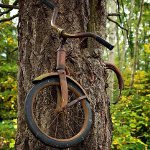
 Besides doing some morning hikes in preparation for leading a week-long trek in the Wyoming wilderness in a couple weeks, I've been living vicariously through my oldest son's bicycle trip across the country. He has my Spot device to track his progress, and I created a website for him to blog about his travels.
Besides doing some morning hikes in preparation for leading a week-long trek in the Wyoming wilderness in a couple weeks, I've been living vicariously through my oldest son's bicycle trip across the country. He has my Spot device to track his progress, and I created a website for him to blog about his travels.If you'd like to check in on an Eagle Scout riding from the Atlantic to Pacific oceans, just check out BikingDude.com and leave him a comment of encouragement. Today, he's halfway through Montana, having started in Boston!
| Leave Comment |
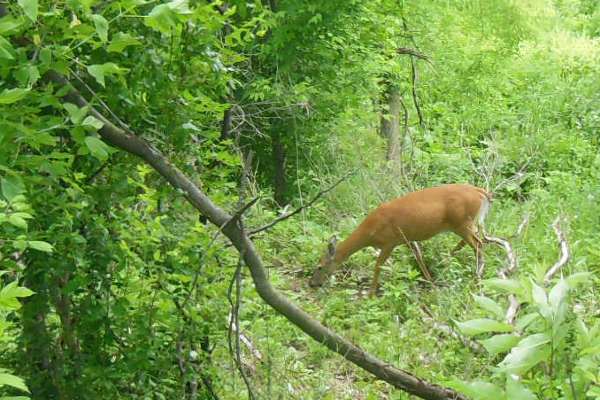
 The animals along the local trails are so nonchalant about humans, it's scary. This deer couldn't care less that I walked by no more than 15 feet from it. I almost stepped on a rabbit before it decided to saunter, not hop, rocket, dodge, bolt, scurry, or run, but just saunter off the trail. Yesterday, two squirrels chased right across the trail, no more than 3 feet in front of me, just playing games and oblivious to my ominous presence.
The animals along the local trails are so nonchalant about humans, it's scary. This deer couldn't care less that I walked by no more than 15 feet from it. I almost stepped on a rabbit before it decided to saunter, not hop, rocket, dodge, bolt, scurry, or run, but just saunter off the trail. Yesterday, two squirrels chased right across the trail, no more than 3 feet in front of me, just playing games and oblivious to my ominous presence.People don't feed these animals, but the trail corridor is a nice green space for them and they are just used to humans walking by. Bicyclists also use the trail and I expect to start seeing some "trailkill" soon as the little critters ignore the danger. Now, if a deer doesn't get out of the way, that will be something interesting!
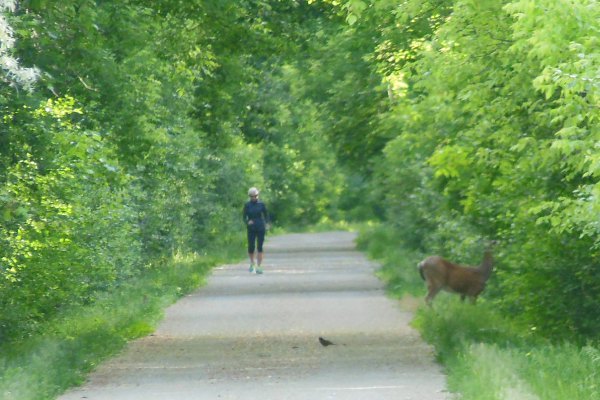
 This is a great time of year for seeing how many different kinds of animals you can find. I routinely count 10 different kinds every morning.
This is a great time of year for seeing how many different kinds of animals you can find. I routinely count 10 different kinds every morning.So, who has the right-of-way when a human, bird, and deer all want the same space? :-)
Keep your eyes and ears open for animals when walking, riding, or driving. The young'uns are growing quickly and exploring away from protective parents, so you might get to see some closer than usual - and maybe too close if you're not careful.
| See 3 comments | Leave Comment |
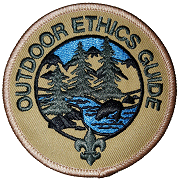

Outdoor Code + Leave No Trace + Tread Lightly + Land Ethic = Outdoor Ethics
Just like that little equation might be confusing, there's been some confusion about the Outdoor Ethics part of the Boy Scouts of America program.
I've heard BSA is breaking ties with Leave No Trace.
I've heard BSA is moving to Tread Lightly! instead of Leave No Trace.
I've heard BSA is creating it's own program.
Those are all incorrect.
The concept of being good stewards of the outdoors is not new to the BSA. Tag lines, catch phrases, logos, promotions, and even best practices come and go, but the underlying desire to use, protect, and conserve outdoor recreational areas remains. The BSA program tries to incorporate the best available study results, partnerships, guidelines, and principles to ensure its members minimize impact while maximizing benefit when participating in outdoor activities.
The BSA's Outdoor Ethics encompasses the principles of Tread Lightly! for motorized activities, Leave No Trace for non-motorized activities, Aldo Leopold's Land Ethic, and the BSA's Outdoor Code for continuity - all mantras being very similar and overlapping in many ways.
Outdoor Code
As an American, I will do my best to be:
- Clean in my outdoor manners -
We will clean up after ourselves using pack it in, pack it out techniques. We avoid leaving graffiti, fire rings, camp gadgets, and other signs of our presence. - Careful with fire -
Fire is an important tool, but one that can be devastating if it gets out of hand. We think about the need for fire, how best to use it, and how to minimize its impacts. - Considerate in the outdoors -
We will think about others as well as ourselves and how our presence impacts them. We think about not just our impact on other humans, but also on wildlife and the environment. - Conservation minded -
We will think about our impacts on the environment. We take steps to correct and redress damage to the environment.
Leave No Trace Principles
- Plan Ahead and Prepare
- Use Durable Surfaces
- Dispose of Waste Properly
- Leave What You Find
- Minimize Campfire Impact
- Respect Wildlife
- Courtesy to Others
Tread Lightly! Principles
- Travel Responsibly on land by staying on designated roads, trails and areas. Go over, not around, obstacles to avoid widening the trails. Cross streams only at designated fords. When possible, avoid wet, muddy trails. On water, stay on designated waterways and launch your watercraft in designated areas.
- Respect the Rights of Others including private property owners, all recreational trail users, campers and others so they can enjoy their recreational activities undisturbed. Leave gates as you found them. Yield right of way to those passing you or going uphill. On water, respect anglers, swimmers, skiers, boaters, divers and those on or near shore.
- Educate Yourself prior to your trip by obtaining travel maps and regulations from public agencies. Plan for your trip, take recreation skills classes and know how to operate your equipment safely.
- Avoid Sensitive Areas on land such as meadows, lakeshores, wetlands and streams. Stay on designated routes. This protects wildlife habitats and sensitive soils from damage. Don't disturb historical, archeological or paleontological sites. On water, avoid operating your watercraft in shallow waters or near shorelines at high speeds.
- Do Your Part by modeling appropriate behavior, leaving the area better than you found it, properly disposing of waste, minimizing the use of fire, avoiding the spread of invasive species and repairing degraded areas.
Land Ethic
The Land Ethic reflects Scouting's historic commitment to conservation and service. It challenges us to include "the land" (soil, water, plants, animals, air, all of nature) as part of our community to love and respect, rather than to conquer and subdue. Ethics direct individuals to cooperate with each other for the mutual benefit of all. The premise of the Land Ethic is that we must include nature in our view of mutual benefit or else we will only see it as a resource to exploit, consume, and discard.
New 2016 Boy Scout Requirements
Each of the first four ranks includes a piece of the Outdoor Ethics picture. These expand on previous requirements and require a more broad understanding of our outdoor ethic. If your troop just follows the principles as "the way we camp", then new scouts will pick up the skills quickly. They may not even realize that they are doing things a certain way in order to minimize their impact - and that would be very cool.
- Scout 1e Repeat from memory the Outdoor Code. In your own words, explain what the Outdoor Code means to you.
- Tenderfoot 1c: Tell how you practiced the Outdoor Code on a campout or outing.
- Second Class 1b:Explain the principles of Leave No Trace and tell how you practiced them on a campout or outing. This outing must be different from the one used for Tenderfoot requirement 1c.
- First Class 1b:Explain each of the principles of Tread Lightly! and tell how you practiced them on a campout or outing. This outing must be different from the ones used for Tenderfoot requirement 1c and Second Class requirement 1b.
Outdoor Ethics Guide
The Leave No Trace Traininer position of responsibility is no more. Instead, we now have the Outdoor Ethics Guide position.
The outdoor ethics guide helps the troop plan and conduct an outdoor program that emphasizes effectively practicing the principles of outdoor ethics. He works to help Scouts improve their outdoor ethics decision-making skills to minimize impacts as they participate in outdoor activities. The guide supports Scouts who are working to complete the relevant requirements for the Tenderfoot, Second Class and First Class ranks.
While the LNT Trainer position required a scout to be at least 14 years old and attend a 16-hour training class, the OE Guide has no training requirement. A scout is appointed to this position by the Senior Patrol Leader, just like other positions of responsibility. But, fulfilling the duties of this position require broad knowledge and developed skills in proper outdoor practices. It makes good sense to have a seasoned scout take on this job to provide adequate leadership to inexperienced scouts so they learn good outdoor ethics - which is much easier than UNlearning bad habits.
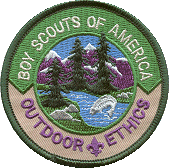
 Outdoor Ethics Awards
Outdoor Ethics Awards
Two awards are available for scouts and Scouters:
- Outdoor Ethics Awareness Award for Cub Scouts or Boy Scouts - an easy recognition to earn by doing a couple online activities and one real world activity.
- Outdoor Ethics Action Award for Cub Scouts or Boy Scouts - expands on the awareness award by implementing the knowledge and sharing with others.
Resources
Here are some web pages with more information about BSA's Outdoor Ethics:
Leave No Trace has been incorporated into the Scout Handbook, program materials, and training for quite a few years now. This latest emphasis in both the Cub Scout and Boy Scout programs shows that the BSA organization understands the need. As a Leave No Trace Master Educator, I'm excited to see the expanded scope. It's now up to the Scoutmasters, Cubmasters, Den Leaders, and other adult volunteers to ensure this education is made part of your unit's program. If you do this, in just a couple years scouts will just think of it as "that's the way we've always done it", and they will be taking care of showing the right way to the new scouts.
If this whole Outdoor Ethics concept is new to you, there are people that can help you grasp it:
- Council Outdoor Ethics Advocate - a council-level volunteer responsible for spreading the word.
- District Outdoor Ethics Advocate - someone in your district to help units develop their OE skills.
- Trainers - Both Leave No Trace and Tread Lightly! have train-the-trainer programs by which they are building armies of trainers that would love to present workshops to your unit, camp, or district.
| See 2 comments | Leave Comment |
Comments:
Feb 25, 2023 - Joe Patterson
Mar 16, 2023 - Adam John
Jan 21, 2024 - Johnna Downing
Scouting 2024 - Ask a Question - Add Content
Just for Fun: Socializing merit badge




Find more Scouting Resources at www.BoyScoutTrail.com



Follow Me, Scouts
Recent Comments